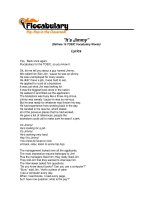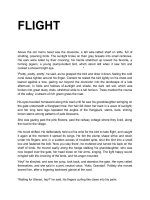Ngôn ngữ đối chiếu - Contrastive Linguistics - Tài liệu học cao học
Bạn đang xem bản rút gọn của tài liệu. Xem và tải ngay bản đầy đủ của tài liệu tại đây (251.6 KB, 51 trang )
CONTRASTIVE
LINGUISTICS
MA Students of English-Vietnamese Contrastive Linguistics
1
A.Objectives:
- understanding the nature of CL;
- analyzing similarities and differences between English
and Vietnamese;
- applying to teaching translation and analyzing errors
2
B.CONTENT:
1.Introduction to Contrastive linguistics
2.Contrastive Linguistics
3.Methodological steps in CL
4.Methods of linguistic description
5.Levels of CA
3
C.References:
1.Bùi Mạnh Hùng (2008) NGÔN NGỮ HỌC ĐỐI CHIẾU, NXB Giáo dục.
2.Chesterman, Andrew (1998) CONTRASTIVE FUNCTIONAL ANALYSIS, John
Benjamins Publishing Company, Amsterdam/ Philadelphia.
3.James, Carl (1992) CONTRASTIVE ANALYSIS, Longman, London and New
York.
4.Lado, Robert (1957) LINGUISTICS ACROSS CULTURES, Michigan University
Press (NGÔN NGỮ HỌC QUA CÁC NỀN VĂN HOÁ (2002) Bản dịch của Hoàng
Văn Vân, NXB ĐHQG Hà Nội).
5.Lê Quang Thiêm (1989 tái bản và bổ sung năm 2005) NGHIÊN CỨU ĐỐI CHIẾU
CÁC NGÔN NGỮ, NXBĐHQG-Hà Nội.
6.Nguyễn Văn Chiến (1992) NGÔN NGỮ HỌC ĐỐI CHIẾU VÀ ĐỐI CHIẾU CÁC
NGÔN NGỮ ĐÔNG NAM Á, Viện KHXHVN, Viện Đông Nam Á - Hà Nội.
7.Nguyễn Thiện Giáp (2009) CÁC PHƯƠNG PHÁP NGHIÊN CỨU NGÔN NGỮ
HỌC, NXB Gíao dục-Hà Nội
8. Krzeszowski, Tomasz P (1990) CONTRASTING LANGUAGES: THE SCOPE OF
CONTRASTIVE LINGUISTICS, Mouton de Gruyter, NY
9.Trần Hữu Mạnh (2007) NGÔN NGỮ HỌC ĐỐI CHIẾU - CÚ PHÁP TIẾNG ANH
- TIẾNG VIỆT, NXB ĐHQG Hà Nội.
4
D.Assessment:
1.Active participation:
20%
2.Group work:
20%
3.Individual work:
60%
5
1.Introduction to Contrastive Linguistics
1.1.Historical development of Contrastive Linguistics
1.1.1.Contrastive analysis is a relatively modern discipline, emerging as a
major linguistic tool during and after World War Two, particularly in the
United States in the context of second and foreign language teaching, but
it has antecedents.
- Contrastive analysis at its strongest, however, began to develop in the
1930s, and the American linguist Benjamin Lee Whorf (1941: 240)
foresaw its place as a successor to the comparative study of languages.
6
1.1.2.Historical linguistics (also called diachronic linguistics) is the study of
language change. It has five main concerns:
• to describe and account for observed changes in particular languages
• to reconstruct the pre-history of languages and determine their
relatedness, grouping them into language families (
comparative linguistics)
• to develop general theories about how and why language changes
• to describe the history of speech communities
• to study the history of words, i.e. etymology.
7
1.1.3. Comparative linguistics (originally comparative philology) is a branch of
historical linguistics that is concerned with comparing languages to establish
their historical relatedness.
Genetic relatedness implies a common origin or proto-language, and comparative
linguistics aims to construct language families, to reconstruct proto-languages and
specify the changes that have resulted in the documented languages.
Scholars were concerned chiefly with establishing language families and
reconstructing prehistoric proto-languages, using the comparative method and
internal reconstruction. The focus was initially on the well-known
Indo-European languages, many of which had long written histories; the scholars
also studied the Uralic languages, another European language family for which
less early written material exists. Since then, there has been significant
comparative linguistic work expanding outside of European languages as well,
such as on the Austronesian languages and various families of
Native American languages, among many others.
8
1.1.4.The fundamental technique of comparative linguistics is to compare
phonological systems, morphological systems, syntax and the lexicon of
two or more languages using techniques such as the comparative method.
In principle, every difference between two related languages should be
explicable to a high degree of plausibility, and systematic changes, for
example in phonological or morphological systems, are expected to be
highly regular (i.e. consistent).
In practice, the comparison may be more restricted, e.g. just to the
lexicon. In some methods it may be possible to reconstruct an earlier
proto-language. Although the proto-languages reconstructed by the
comparative method are hypothetical, a reconstruction may have
predictive power.
•
9
1.Introduction to Contrastive Linguistics
1.2.Theoretical Background
1.2.1.CL based its theory on transfer theory of behaviorism in psychology.
The psychological basis of CL is Transfer Theory, elaborated and
formulated within a Stimulus (S) – Response (S) (Behaviorist) theory of
psychology: “One explanation [of L2 errors] is that the learner is carrying
over the habits of his mother tongue into the second language. Clearly,
this explanation is related to a view of language as some sort of habitstructure” CL was used extensively in the field of
Second Language Acquisition (SLA) in the 1960s and early 1970s, as a
method of explaining why some features of a Target Language were more
difficult to acquire than others. According to the behaviourist theories
prevailing at the time, language learning was a question of
habit formation, and this could be reinforced or impeded by existing
habits. Therefore, the difficulty in mastering certain structures in a
second language (L2) depended on the difference between the learners'
mother language (L1) and the language they were trying to learn.
10
1.2.1.1.Charles C. Fries whose Teaching and Learning English as a Foreign
Language was published in 1945 stated that the learner was likely to
transfer rules about language internalized from the learning of his/her L1
to the L2, and that mistakes in the L2 were due to this inappropriate
transference. One could therefore prevent development of errors through
a prior contrastive analysis and error analysis, leading to the development
of appropriate teaching materials to reinforce correct language learning.
“Learning a second language…constitutes a very different task from
learning the first language. The basic problems arise not out of any
essential difficulty in the features of the new language themselves but
primarily out of the special “set” created by the first language habits”.
The existence of cross-linguistic differences made second language
acquisition extremely different from first language acquisition.
11
1.2.1.2.Robert Lado in Linguistics Across Cultures (1957) claimed: “We
assume that the student who comes in contact with a foreign language will
find some features of it quite easy and others extremely difficult. Those
elements that are similar to his native language will be simple for him,
and those elements that are different will be difficult. The teacher who has
made a comparison of the foreign language with the native language of
the students will know better what the real learning problems are and can
better provide for teaching them”.
“L2 learners will tend to transfer to their L2 utterances the formal
features of their L1, that means: “individuals tend to transfer the forms
and meanings and the distribution of forms and meanings of their native
language and culture to the foreign language and culture” (Lado, 1957)
12
1.2.2.Contrastive linguistics based its theory on structuralism.
1.2.2.1.From Pre-Structuralism to Structuralism to Post-Structuralism
• A. Pre-structuralist theory assumes that there is an intimate connection
between material objects in the world and the languages that we use to
talk about those objects and their interrelations.
• B. Structuralism originated in the early 1900s, in the structural
linguistics of Ferdinand de Saussure. Structuralism is a theoretical
paradigm emphasizing that elements of culture must be understood in
terms of their relationship to a larger, overarching system or structure.
Structuralism is "the belief that phenomena of human life are not
intelligible except through their interrelations. These relations constitute a
structure, and behind local variations in the surface phenomena there are
constant laws of abstract culture".
13
1.2.2.2. Structuralism: Early in the 20th century, Saussure introduced the idea
of language as a static system of interconnected units, defined through the
oppositions between them.
- By introducing a distinction between diachronic to synchronic analyses of
language, he laid the foundation of the modern discipline of linguistics.
- Saussure also introduced several basic dimensions of linguistic analysis that
are still foundational in many contemporary linguistic theories, such as the
distinctions between syntagm and paradigm,
- and the langue - parole distinction, distinguishing language as an abstract
system (langue) from language as a concrete manifestation of this system
(parole).
Substantial additional contributions following Saussure's definition of a
structural approach to language came from The Prague school, Leonard
Bloomfield, Charles F. Hockett, Louis Hjelmslev, Émile Benveniste
and Roman Jakobson.
-
14
In brief, de Saussure's structural linguistics propounded three related
concepts.
• a) De Saussure argued for a distinction between langue (an idealized
abstraction of language) and parole (language as actually used in daily
life)
• b) He argued that the "sign" was composed of both a signified, an
abstract concept or idea, and a "signifier", the perceived sound/visual
image. Because different languages have different words to describe the
same objects or concepts, there is no intrinsic reason why a specific sign is
used to express a given signifier. It is thus "arbitrary".
• c) Signs thus gain their meaning from their relationships and contrasts
with other signs.
15
According to Saussure's structuralist theory of language, the meaning of
a term (a word or expression) does not begin and end with the speaker's
experience or intention.
In other words, the meaning of a particular term in a language is due to
its relative difference from all other terms in the language.
A signified, i.e. a concept or idea, is properly understood in terms of its
position relative to the differences among a range of other signifiers
(words with different positions in the network (langue) and, hence,
different meanings).
16
The Significance of Structuralist Theory
• The first thing to notice is that, according to structuralist theory, meaning is not a
private experience, but the product of a shared system of signification. A text is to
be understood as a construct to be analyzed and explained scientifically in terms of
the deep-structure of the system itself. For many structuralists, this "deepstructure" is universal and innate.
• Second we should note that in structuralism, the individual is more a product of
the system than a producer of it. Language precedes us. It is the medium of
thought and human expression. Thus, it provides us with the structure that we use
to conceptualize our own experience.
• And third, since language is arbitrary, there is no natural bond between words and
things, there can be no privileged connection between language and reality. In this
sense, reality is also produced by language. Thus, structuralism can be understood
as a form of idealism.
17
• According to structuralist theory, a text or utterance has a "meaning", but
its meaning is determined not by the psychological state or "intention" of
the speaker, but by the deep-structure of the language system in which it
occurs. In this way, the subject (individual or "author") is effectively
killed off and replaced by language itself as an autonomous system of
rules. Thus, structuralism has been characterized as anti-humanistic in
it's claim that meaning is not identical with the inner psychological
experience of the speaker. It removes the human subject from its central
position in the production of meaning much.
18
C. In the late 1950s and early '60s, when structural linguistics was facing serious
challenges from the likes of Noam Chomsky and thus fading in importance, an
array of scholars in the humanities borrowed Saussure's concepts for use in their
respective fields of study. French anthropologist Claude Lévi-Strauss was
arguably the first such scholar, sparking a widespread interest in Structuralism.
* Poststructuralist theory denies the distinction between signifier and signified.
According to the poststructuralist, concepts are nothing more than words. If a
word's meaning is solely the result of its difference from other words, then the
meaning (the concept or signified) is not an additional thing "present" in the sign
itself. On the contrary, "meaning" (if it can be called that at all) is the evermoving play of difference from signifier to signifier; a slipping from word to word
in which each word retains relations to ("traces" of) the words that differ from it.
1. Meaning is never fully present in any one signifier, but is infinitely deferred or
suspended.
2. Meaning is contextual, i.e. affected by related words.
3. There is always an excess of meaning.
19
C.1. Generative Linguistics
• During the last half of the 20th century, following the work of Noam Chomsky
, linguistics was dominated by the generativist school. While formulated by
Chomsky in part as a way to explain how human beings acquire language and
the biological constraints on this acquisition, in practice it has largely been
concerned with giving formal accounts of specific phenomena in natural
languages. Generative theory is modularist and formalist in character.
Chomsky built on earlier work of Zellig Harris to formulate the generative
theory of language.
• According to this theory the most basic form of language is a set of syntactic
rules universal for all humans and underlying the grammars of all human
languages. This set of rules is called Universal Grammar, and for Chomsky
describing it is the primary objective of the discipline of linguistics. For this
reason the grammars of individual languages are of importance to linguistics
only in so far as they allow us to discern the universal underlying rules from
which the observable linguistic variability is generated.
20
• Generative linguistics is a school of thought within linguistics that makes use
of the concept of a generative grammar. The term "generative grammar" is
used in different ways by different people, and the term "generative
linguistics" therefore has a range of different, though overlapping, meanings.
• Formally, a generative grammar is defined as one that is fully explicit. It is a
finite set of rules that can be applied to generate all those and only those
sentences (often, but not necessarily, infinite in number) that are grammatical
in a given language. This is the definition that is offered by Noam Chomsky,
who invented the term [1] , and by most dictionaries of linguistics. It is
important to note that generate is being used as a technical term with a
particular sense. To say that a grammar generates a sentence means that the
grammar "assigns a structural description" to the sentence.[2]
•
21
• The term generative grammar is also used to label the approach to
linguistics taken by Chomsky and his followers.
• Chomsky's approach is characterised by the use of transformational
grammar – a theory that has changed greatly since it was first
promulgated by Chomsky in his 1957 book Syntactic Structures – and by
the assertion of a strong linguistic nativism (and therefore an assertion
that some set of fundamental characteristics of all human languages must
be the same).
• The term "generative linguistics" is often applied to the earliest version of
Chomsky's transformational grammar, which was associated with a
distinction between the "deep structure" and "surface structure" of
sentences.
22
• In the classic formalization of generative grammars first proposed by
Noam Chomsky in the 1950s, a grammar G consists of the following
components:
- A finite set N of non-terminal symbols, none of which appear in strings
formed from G.
- A finite set of terminal symbols that is disjoint from N.
- A finite set P of production rules, that map from one string of symbols to
another.
- A formal description of language attempts to replicate a speaker's
knowledge of the rules of their language, and the aim is to produce a set
of rules that is minimally sufficient to successfully model valid linguistic
forms.
23
C.2. Functionalism
C.2.1.Functional theories of language propose that since language is
fundamentally a tool, it is reasonable to assume that its structures are best
analyzed and understood with reference to the functions they carry out.
• Functional theories of grammar differ from formal theories of grammar,
in that the latter seeks to define the different elements of language and
describe the way they relate to each other as systems of formal rules or
operations, whereas the former defines the functions performed by
language and then relates these functions to the linguistic elements that
carry them out. This means that functional theories of grammar tend to
pay attention to the way language is actually used, and not just to the
formal relations between linguistic elements.
24
• Functional theories then describe language in term of functions existing
on all levels of language.
- Phonological function: the function of the phoneme is to distinguish
between different lexical material.
- Semantic function: (Agent, Patient, Recipient, etc.), describing the role
of participants in states of affairs or actions expressed.
- Syntactic functions: (e.g. Subject and Object), defining different
perspectives in the presentation of a linguistic expression
- Pragmatic functions: (eg.Theme and Rheme, Topic and Focus, Predicate
), defining the informational status of constituents, determined by the
pragmatic context of the verbal interaction.
• Functional descriptions of grammar strive to explain how linguistic
functions are performed in communication through the use of linguistic
forms.
25









